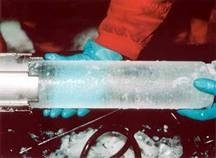Ice core
1) Ice cores are cylinder – shaped samples of ice drilled out of an ice sheet or glacier.
Glaciers form as layers of snow accumulate on top of each other. Each layer of snow is different in chemistry and texture, summer snow differing from winter snow. Over time, the buried snow compresses under the weight of the snow above it, forming ice. Particulates and dissolved chemicals that were captured by the falling snow become a part of the ice, as do bubbles of trapped air. Layers of ice accumulate over seasons and years, creating a record of the climate conditions at the time of formation, including snow accumulation, local temperature, the chemical composition of the atmosphere including greenhouse gas concentrations, volcanic activity, and solar activity.
Each layer gives scientists a treasure trove of information about the climate each year. Like marine sediment cores, an ice core provides a vertical timeline of past climates stored in ice sheets and mountain glaciers.
Ice core records provide the most direct and detailed way to investigate past climate and atmospheric conditions. Ice cores are drilled in glaciers and on ice sheets on all of Earth’s continents. Most ice cores, however, come from Antarctica and Greenland, where the longest ice cores extend to 3 km or more in depth. Ice cores from the cold interior regions of polar ice sheets provide exceptionally well-preserved and detailed climate records.
Studying ice cores shows how ancient ice contains records of Earth’s past climate. Over 400,000 years, levels of carbon dioxide have risen and fallen, varying from colder in the Ice Ages to warmer in interglacial periods.
2) Ice core is a fragment of glacial ice preserved within frontal or lateral moraine or a lens of ice formed inside a pingo.



 This project (EDU-ARCTIC) has received funding from the European Union’s Horizon 2020 research and innovation programme under grant agreement No 710240. The content of the website is the sole responsibility of the Consortium and it does not represent the opinion of the European Commission, and the Commission is not responsible for any use that might be made of information contained.
This project (EDU-ARCTIC) has received funding from the European Union’s Horizon 2020 research and innovation programme under grant agreement No 710240. The content of the website is the sole responsibility of the Consortium and it does not represent the opinion of the European Commission, and the Commission is not responsible for any use that might be made of information contained.